NUR 229 Pharmacology Test #1 OEK
ATI NUR 229 Pharmacology Test #1 OEK
Total Questions : 44
Showing 10 questions Sign up for moreA nurse is giving discharge instructions to a patient who has been ordered Guaifenesin (Mucinex) to take BID for 3 days after discharge. What response by the patient lets her know that he understands how to take his medication?
Explanation
This response demonstrates that the patient understands the dosing frequency (twice a day) and the importance of taking it with a full glass of water, which aligns with the instructions provided by the nurse.
The other choices are incorrect because:
A. "Taking this medication can cause me to develop a non-productive cough.": This response is about a potential side effect of the medication, rather than showing an understanding of the dosing instructions.
B. "I will take my medication Daily with a full glass of water.": This response indicates a misunderstanding of the dosing frequency, as the prescription specifically states "BID" (twice a day) rather than "daily."
D. "The medication will have to be given by my Home Health Nurse twice a day.": This response suggests a reliance on the home health nurse to administer the medication, which contradicts the instructions for the patient to take it themselves. It shows a misunderstanding of the patient's responsibility in self-administering the medication.
Which type of medication is the first-line treatment for nasal congestion?
Explanation
Nasal glucocorticoids, also known as intranasal corticosteroids, are considered the most effective and recommended first-line treatment for nasal congestion caused by allergic rhinitis or non-allergic rhinitis. They work by reducing inflammation in the nasal passages, relieving congestion, and improving other symptoms such as itching, sneezing, and runny nose.
Leukotriene modifiers, decongestants, and antihistamines can also be used to manage nasal congestion, but they are generally considered second-line options or adjunct therapies.
Decongestants provide temporary relief by constricting blood vessels in the nasal passages, while antihistamines help with symptoms related to allergies. Leukotriene modifiers are primarily used for managing asthma and are not typically the first choice for nasal congestion alone.
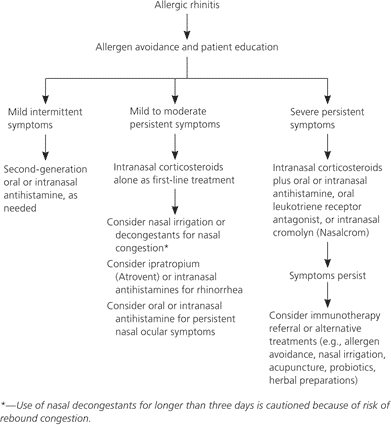
The sympathetic nervous system postganglionic neuron releases what neurotransmitter?
Explanation
The sympathetic nervous system postganglionic neurons primarily release norepinephrine as their neurotransmitter. These neurons are part of the autonomic nervous system and are responsible for coordinating the body's "fight or flight" response to stress or danger.
Norepinephrine acts as a neurotransmitter at the postganglionic synapses and binds to adrenergic receptors in the target tissues, mediating the physiological responses associated with sympathetic activation.
While acetylcholine is the primary neurotransmitter released by the preganglionic neurons of the sympathetic nervous system, it is not the neurotransmitter released by postganglionic neurons. Epinephrine (also known as adrenaline) is released into the bloodstream by the adrenal medulla and acts as a hormone, not a neurotransmitter. Arginine is an amino acid and is not directly involved in the neurotransmission of the sympathetic nervous system.
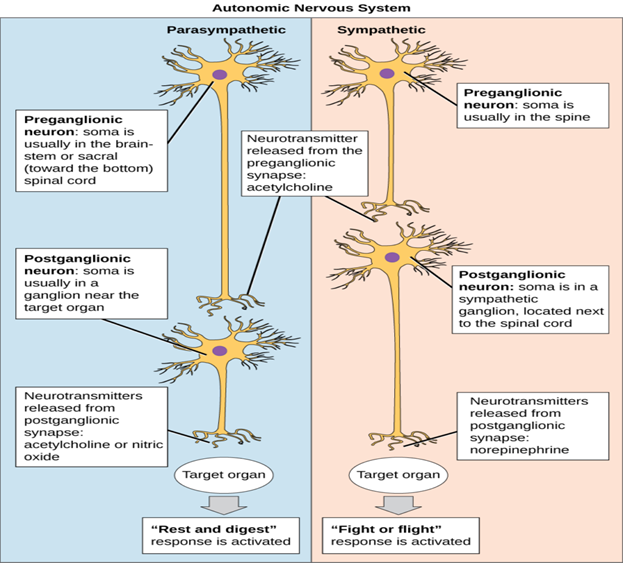
A nurse is caring for a client who is taking montelukast. Which of the following outcomes indicates a therapeutic effect of the medication?
Explanation
Montelukast is a leukotriene receptor antagonist commonly used to manage asthma and allergic rhinitis. Its primary therapeutic effect is to improve respiratory symptoms by reducing inflammation and constriction of the airways. Therefore, an increased ease of breathing would be an expected outcome indicating that the medication is working effectively.
The other options are incorrect because:
A. The client's seizure threshold is reduced: Montelukast does not have any effect on the seizure threshold. This outcome is unrelated to the medication and may be indicative of a different condition or treatment.
B. The client experiences less muscle pain: Montelukast is not indicated for reducing muscle pain. This outcome is unrelated to the medication and may be indicative of a different condition or treatment.
D. The client's platelet count is increased: Montelukast does not have an effect on platelet count. This outcome is unrelated to the medication and may be indicative of a different condition or treatment.
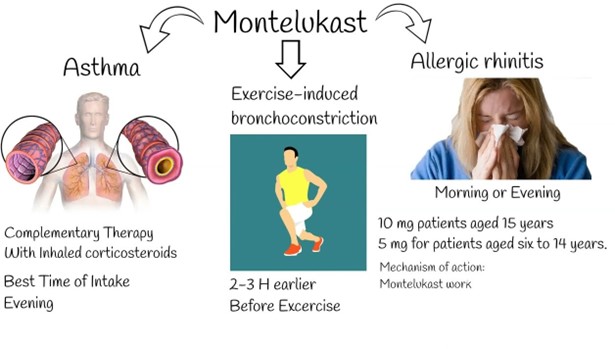
Patient teaching regarding expectorants should instruct the patient to perform which action?
Explanation
Expectorants are medications that help thin and loosen mucus in the respiratory tract, making it easier to cough up and clear from the airways. Increasing fluid intake, particularly water helps to keep the mucus thin and less sticky, facilitating its removal. Adequate hydration can help promote effective expectoration and relieve congestion.
The other options are incorrect because:
B. Taking the medication once a day only, usually at bedtime: The dosing frequency and timing of expectorants can vary depending on the specific medication prescribed. It is important to follow the healthcare provider's instructions regarding the dosing schedule.
C. Increase fiber and fluid intake to prevent constipation: This instruction is unrelated to expectorant use. Increasing fiber and fluid intake is commonly recommended to promote regular bowel movements and prevent constipation, but it is not directly related to expectorant therapy.
D. Restrict fluids to decrease mucus production: Restricting fluids can lead to dehydration and thickening of mucus secretions. It is important to stay adequately hydrated to maintain thin and easily expectorated mucus. Restricting fluids is not recommended for managing mucus production.
A nurse is caring for a client who asks how albuterol helps his breathing. Which of the following responses should the nurse make? (Select all that apply.)
Explanation
The nurse should make the following responses regarding how albuterol helps the client's breathing:
- The medication will open the airways.
- The medication will prevent wheezing.
Albuterol is a bronchodilator medication commonly used to treat respiratory conditions such as asthma and chronic obstructive pulmonary disease (COPD). It works by relaxing the smooth muscles in the airways, leading to the dilation of the bronchial tubes and increased airflow. This mechanism helps open up the airways and prevent or relieve symptoms such as wheezing, shortness of breath, and chest tightness.
The other options are incorrect because:
The medication will decrease coughing episodes: While albuterol may indirectly reduce coughing episodes by opening up the airways and improving airflow, its primary effect is on bronchodilation rather than directly targeting coughing.
The medication will stimulate the flow of mucus: Albuterol is not known to stimulate mucus flow. Instead, it focuses on bronchodilation to improve airflow in the lungs.
The medication will reduce inflammation: Albuterol is primarily a bronchodilator and does not have a significant anti-inflammatory effect. Other medications, such as corticosteroids, are typically used to address inflammation in respiratory conditions.
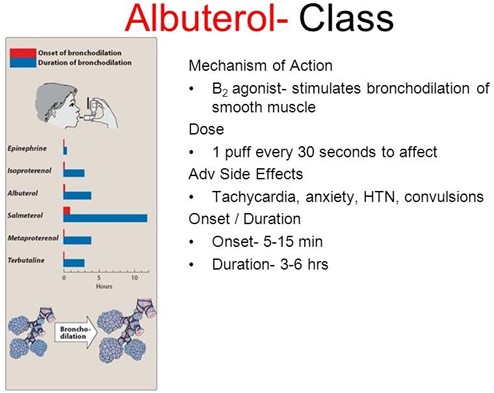
A patient is in an urgent care center with an acute asthma attack. The nurse expects which medication will be used for initial treatment.
Explanation
During an acute asthma attack, the airways become narrowed and inflamed, leading to symptoms such as wheezing, shortness of breath, and chest tightness. Short-acting beta2 agonists like Albuterol are the first-line medication for relieving acute asthma symptoms. They work by quickly relaxing the smooth muscles in the airways, resulting in bronchodilation and improved airflow. Albuterol provides rapid relief of symptoms and is often administered via inhalation.
A. Long-acting beta2 agonists (e.g., salmeterol) are typically used as maintenance therapy for long-term control of asthma symptoms, rather than for immediate relief during an acute attack.
C. Corticosteroids (e.g., fluticasone) are anti-inflammatory medications that are often prescribed for asthma, but they are more commonly used as part of a long-term management plan and may not provide immediate relief during an acute attack.
D. Anticholinergics (e.g., ipratropium) are sometimes used in combination with short-acting beta2 agonists for acute asthma exacerbations, but they are not typically the initial treatment choice for an acute asthma attack.
A nurse is preparing to administer a medication to a client who states. "That looks different from the pill I usually take." Which of the following responses should the nurse make?
Explanation
A. "This pill is probably from a different lot number than yours at home." While lot numbers may vary between different batches of medications, it does not address the client's concern about the difference in appearance. It does not provide a direct explanation or reassurance regarding the medication they are about to take.
B. "This hospital might use a different manufacturer, but the medication is the same." This response acknowledges the possibility of a different manufacturer but does not directly address the client's concern about the difference in appearance. It may not provide sufficient reassurance regarding the medication they are about to receive.
c."This is the medication prescribed by your provider." This does not address the client's concern about the medication's appearance and may dismiss the possibility of an error.
D. "Describe what the pill looks like." This response allows the nurse to gather more information, verify the medication, and ensure that the correct medication is being administered.
A nurse is providing discharge instructions to a client who has asthma and is about to start taking theophylline (Theo-24). The nurse should tell the client that this medication might cause which of the following adverse effects?
Explanation
Theophylline is a bronchodilator medication used in the treatment of asthma and other respiratory conditions. It works by relaxing the smooth muscles in the airways, allowing for easier breathing. However, theophylline is associated with potential adverse effects, and one of the most significant concerns is its potential to cause dysrhythmias (irregular heart rhythms).
Dysrhythmias can include tachycardia (rapid heart rate), atrial fibrillation, or other disturbances in heart rhythm.
Constipation is not a commonly reported adverse effect of theophylline. Oliguria (decreased urine output) is not typically associated with theophylline use. Drowsiness can occur with theophylline, but dysrhythmias are considered a more significant and potentially serious adverse effect. It is crucial for the nurse to educate the client about the potential for dysrhythmias and advise them to report any irregular heartbeat or other cardiac symptoms promptly.
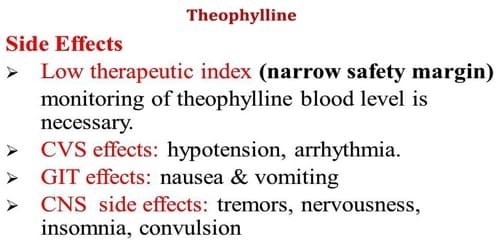
A nurse is providing discharge teaching to a client who has asthma and a new prescription for fluticasone/salmeterol. For which of the following adverse effects should the nurse instruct the client to report to the provider?
Explanation
White coating in the mouth: A white coating in the mouth could be a sign of a fungal infection such as oral thrush. Fluticasone, which is a corticosteroid, can increase the risk of developing fungal infections. Therefore, the nurse should instruct the client to report any signs of oral thrush or other unusual changes in the mouth, such as white patches or discomfort, to the provider.
Prompt identification and treatment of oral thrush are necessary to prevent its progression and ensure effective management of the client's condition.
Dry oral mucous membranes: Dry oral mucous membranes are not typically associated with fluticasone/salmeterol use. However, if the client experiences persistent or severe dryness in the mouth or any other unusual oral symptoms, it should be reported to the provider. Dry mouth can sometimes occur as a side effect of medications or indicate other underlying issues that need to be addressed.
Sedation: Sedation is not a common side effect of fluticasone/salmeterol. If the client experiences excessive drowsiness or sedation that interferes with their daily activities, it may be important to report this to the provider. While sedation is not a typical adverse effect of this medication, individual responses can vary, and it is essential to ensure appropriate monitoring and management.
Increased appetite is not typically associated with fluticasone/salmeterol use. It is not a commonly reported adverse effect of the medication. However, if the client experiences significant and unexplained changes in appetite that are concerning or persistent, it may be worth mentioning to the provider during a follow-up appointment or as part of ongoing monitoring.
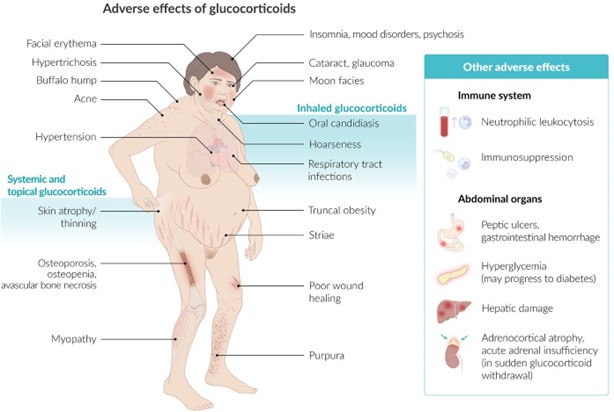
You just viewed 10 questions out of the 44 questions on the ATI NUR 229 Pharmacology Test #1 OEK Exam. Subscribe to our Premium Package to obtain access on all the questions and have unlimited access on all Exams. Subscribe Now



